Best white flowers to plant in gardens: White flowers are the best choice if you want to achieve a classy and elegant garden.
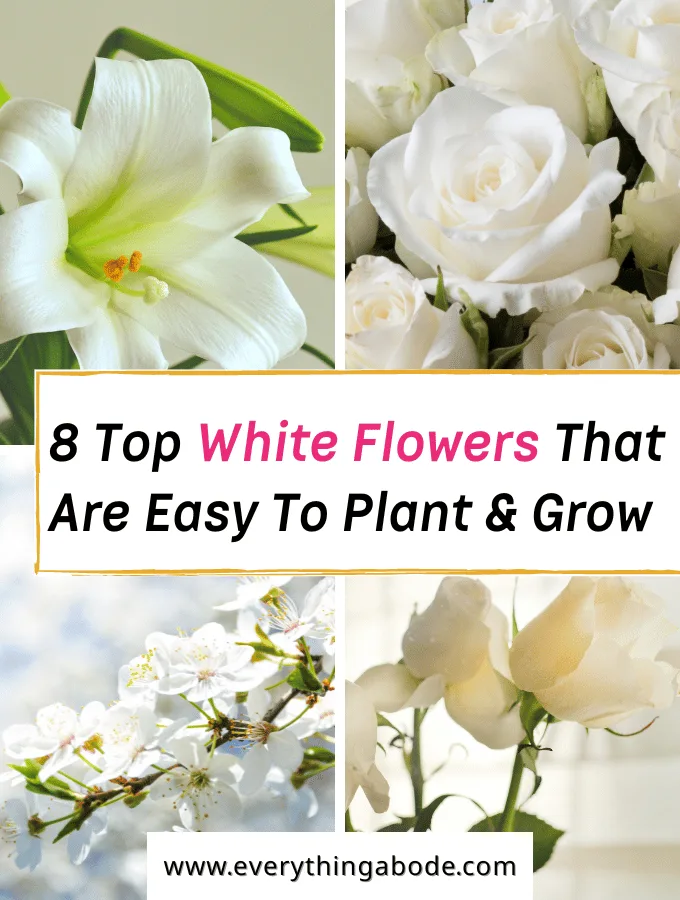
White flowers symbolize elegance, purity, and tranquility, making beautiful additions to any yard.
If you plan to create a tranquil setting or a sophisticated garden or wish to lighten a dull space, white flowers can bring a touch of elegance.
From the delicate bells and lilies of Lily of the Valley to the whole, round blossoms of Hydrangeas, white flowers will suit any garden style and climate.
So, if you are considering planting a gorgeous garden this year, look at our carefully selected selection of stunning white flowers.
These flowers can transform your outdoor space into an elegant and charming haven.
Why Choose White Flowers for Your Garden?
White flowers are ideal for any garden because of their classic beauty and versatility.
They symbolize purity, innocence, and peace, which is why they are suitable for creating a peaceful and tranquil setting.
White can lighten shaded areas and contrast vibrant flowers, making them a significant element of any garden.
The neutral colors blend effortlessly with any landscaping style, adding to the overall appearance.
This create a feeling of elegance and harmony When used in formal gardens, contemporary gardens, or even cottage-style gardens.
SEE ALSO:
Planning Your White Flower Garden
If you’re planning a white-flower garden, consider factors such as sun soil type, sun exposure, and the climate.
Start by choosing a selection of white flowers that blossom at various times of the year to ensure the garden’s beauty.
For instance, Snowdrops and White Tulips flower in the early spring, White Roses and White Hydrangeas in the summer months, and White Carnations and Calla Lilies from late spring through the beginning of summer.
Set taller flowers like White Hydrangeas and White Roses towards the back of your garden bed and smaller flowers like Snowdrops and Lily of the Valley towards the front.
Be sure that each plant gets enough space to grow and gets enough sunlight.
Include plants of different styles and textures to provide visual interest.
A well-drained, fertile soil with organic matter will flourish your white flowers. Regularly applying water and mulch can ensure soil moisture and stop the growth of weeds.
SEE ALSO: 7 Best Clinging Vines That Climb On Anything
White Flowers for Different Garden Styles
Formal gardens: White Roses and White Hydrangeas are incredible for formal gardens because of their well-structured blooms and classic beauty. Plant them in symmetrical patterns or on pathways to create an elegant and sophisticated style.
Cottage Garden: Mix white Carnations with White Tulips for a lovely and tranquil cottage garden. The delicate, ruffled petals and blooms are perfect for the casual, affluent cottage garden style.
Contemporary Gardens: Calla Lilies and White Carnations work well in modern gardens thanks to their sleek lines and simple yet striking shapes. Plant them in minimal arrangements or containers to give your garden a contemporary appeal.
Woodland Gardens: Lily of the Valley and Snowdrops are fantastic for woodland gardens because they prefer shade and a natural appearance. Plant them in groups in shaded border plants to give a tranquil, woodland-like look.
SIMILAR:
Pure Beauty: 8 Top White Flowers for Your Garden
Here are our top eight white flowers you should plant this year!
*All the white flowers are shoppable*
1. Calla Lily (Zantedeschia sp.)
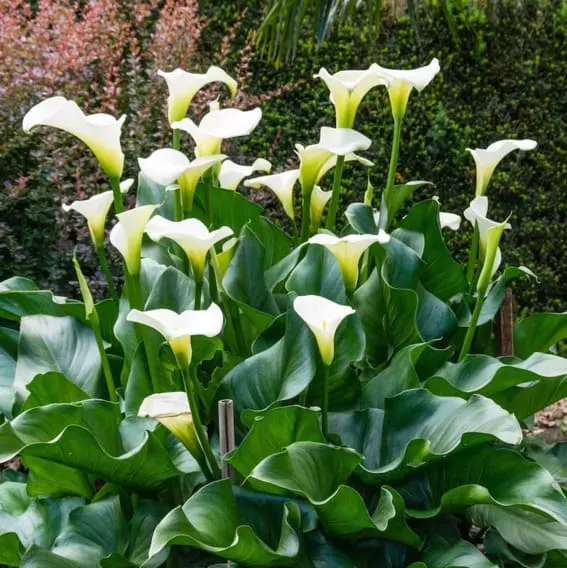
Calla Lilies are stunning but straightforward flowers often featured in bridal bouquets, Easter arrangements, and funeral ceremonies due to their significance in purity, resurrection, and rebirth.
The delicate perennials have beautiful, chalice-shaped flowers and may be grown in garden borders, containers, or borders that can reach heights up to 3 feet.
They are also great as indoor plants, adding a bit of class to any indoor area.
Flowers: Calla Lilies have smooth, trumpet-shaped flowers in various colors, including white. They are known for their elegant and simple beauty, making them popular in floral arrangements and gardens.
Foliage: Calla lily leaves are typically dark green, glossy, and arrow-shaped. They can add a lush, tropical feel to any planting area.
Toxicity: Calla Lilies are toxic to pets and humans if ingested. They contain calcium oxalate crystals, which can cause irritation, swelling, and difficulty swallowing.
TIP: To get the best growth, cultivate Calla Lilies in well-drained soil and ensure they get full or partial sunshine. Water regularly so the soil remains moist but not soggy.
2. Gardenia (Gardenia jasminoides)
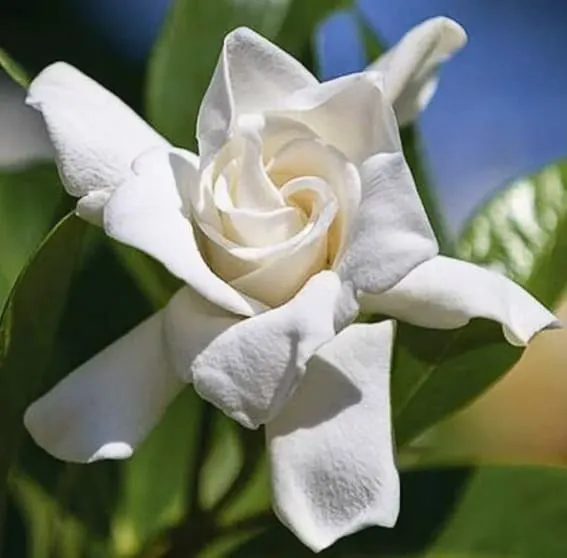
In the warmth of late spring and early summer, many southern gardens are filled with the heady perfume of blooming Gardenia plants.
Even if you don’t reside in a sultry southern climate, you can still enjoy the creamy white flowers and intoxicating fragrance of these striking evergreen shrubs by providing them with the subtropical conditions they love.
Gardenias thrive in full sun to partial shade, needing protection from the hot afternoon sun.
Blooming typically occurs from May to June, with some varieties experiencing sporadic rebloom into fall.
Flowers: Gardenia flowers are usually white, featuring single, semi-double, or double blossoms that range from 2 to 5 inches in diameter. Some cultivars, such as ‘Golden Magic,’ produce buttery yellow blossoms.
Foliage: Gardenias have glossy, dark green leaves 2 to 4 inches long and maintain their attractiveness throughout the year.
Toxicity: Gardenias are poisonous to pets and children, containing toxic properties, including saponins and glycosides.
3. Snowdrops (Galanthus nivalis)
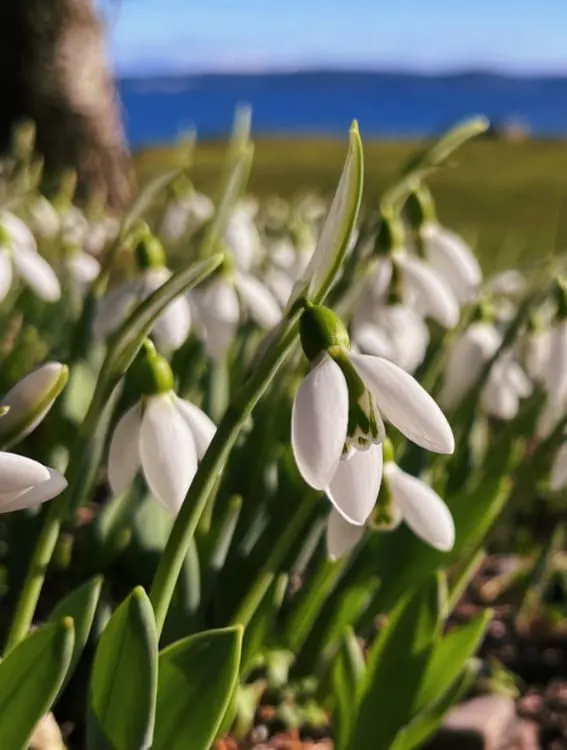
Snowdrops are tiny, delicate blooms that mark their end to winter through their early blooming and are often the first flower of the season.
They are adored for their bell-shaped, drooping white flowers, symbolizing the hope of renewal and optimism.
They thrive in soil that is well-drained and like partial shade, making them great for woodland gardens and shaded border plants.
They are durable, easy to cultivate and blend well in various garden settings.
Flowers: Snowdrops are generally white and have an oblong shape. They have three inner petals, which tend to be highlighted with green at their ends, surrounded by three bigger outer petals. They bloom from the winter months from late winter until early spring, creating an attractive contrast to the winter landscape.
Foliage: The leaves on Snowdrops are short, straight, and dark green. They grow from the ground with flower stems and give gardens a soft, grassy appearance.
Toxicity: Snowdrops contain alkaloids that can be harmful if taken in large amounts. They can trigger nausea, vomiting, and diarrhea, which is why it’s crucial to keep them from pets and children who may be enticed to eat them.
4. White Roses (Rosa spp.)
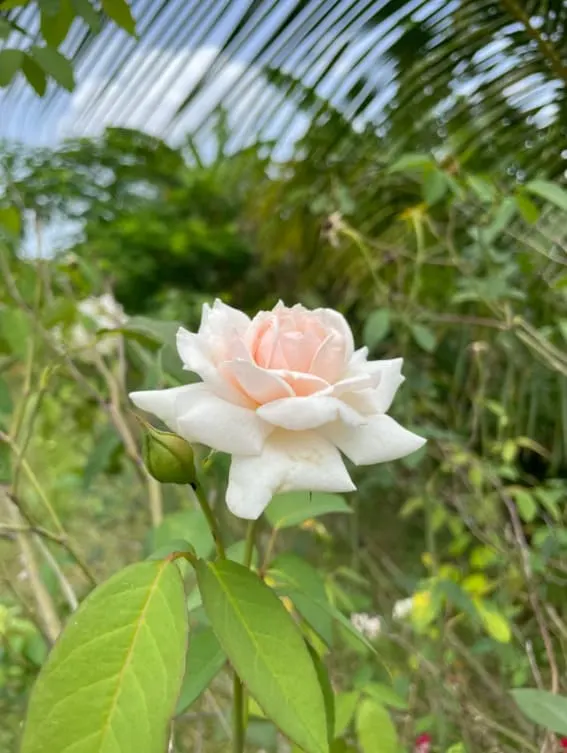
White Roses are classic and sophisticated flowers that signify purity of innocence, purity, and fresh beginnings.
They are loved because of their timeless beauty and are often utilized for wedding bouquets, garden displays, or formal floral arrangements.
The white Roses thrive in soil that is well-drained and full sun.
They are a great choice in various garden settings, including borders, beds, and containers.
They are tough and flourish if correctly cared for, including regular pruning and disease control.
Flowers: White Rose flowers consist of soft, smooth petals that make an entire, round flower. They are a variety of sizes in appearance, with some producing huge, spectacular flowers while others produce smaller, delicate flowers. The scent of white roses can vary from delicate to sweet and intense.
Foliage: White rose foliage is typically dark green, shiny, and sharp-edged. It provides a stunning backdrop for the beautiful blooms and helps to improve the plants’ general health and strength.
Toxicity: The white Roses are generally safe for pets and humans, making them a good option for homes and gardens in which animals and children are nearby. But, it is always best to take care when handling plants and to avoid eating any of the parts of their leaves.
5. White Tulip (Tulipa spp.)
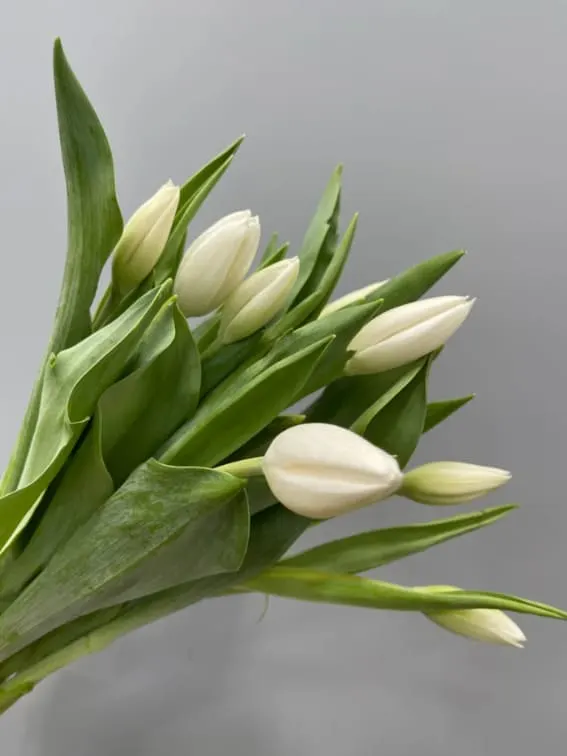
White Tulips are the most popular spring flowers.
They are known for their simplicity, purity, and symbolic meaning of respect, forgiveness, and purity.
They’re an excellent selection for garden beds, borders, and containers and are utilized in beautiful arrangements of flowers.
White tulips thrive on well-drained soil and like full to partial sun.
They are relatively easy to cultivate and require little maintenance, so they are a favorite for gardeners.
Flowers: White tulips’ flowers are cup-shaped, with soft, smooth petals that make an elegant and striking flower. They grow tall on slim stems and can grow to an average height of 10 to 24 inches. The pure white hue of the flowers makes them a popular option for many different decorative uses.
Foliage: The leaves of White Tulips form a lance, green and a little waxy. They are part of the plant’s root and contrast with the pristine white flowers.
Toxicity: They contain compounds such as glycosides and alkaloids, which can be harmful when ingested by animals or humans. Consuming parts of the plant could cause symptoms such as nausea, vomiting, and throat and mouth irritation. To prevent accidental consumption, keeping tulips away from the reach of pets and children is essential.
6. Lily of the Valley (Convallaria Majalis)
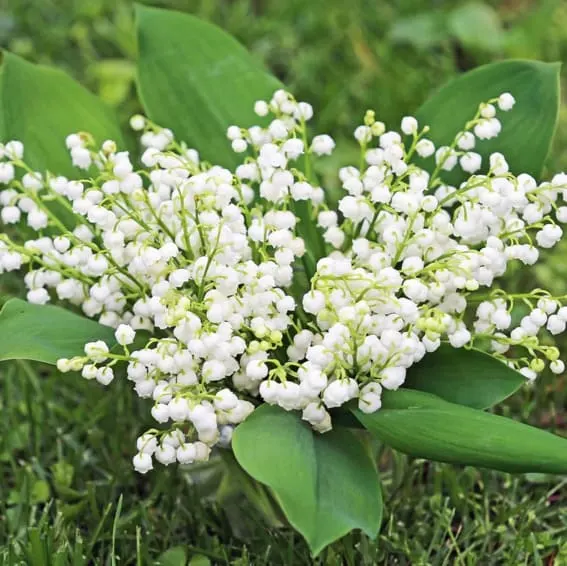
Lily of the Valley is a cherished perennial renowned for its delicate bell-shaped white flowers and enchanting scent.
The flowers bloom in the late spring. these flowers symbolize sweetness, humility, and the return to happiness.
They’re ideal for shaded garden areas as well as woodland areas and border plantings that are shaded.
Lily of the Valley thrives in well-drained, moist, and shaded soil, partial to complete. These plants with low growth form large colonies, which makes them ideal groundcovers.
Flowers: Lily of the Valley’s small, bell-shaped, nodding flowers are pure white and incredibly aromatic. Each flower typically has five to fifteen blossoms, which make a lovely and elegant appearance when viewed from the outside. The flowers bloom in late spring, bringing a pleasant smell and attractive visual.
Foliage: Lily of the Valley has large, lance-shaped dark green leaves that develop in pairs at the base. The leaves are attractive throughout the season and add lush greenery to shaded garden areas.
Toxicity: Every part of Lily of the Valley is highly toxic when consumed with cardiac glycosides, which may cause severe reactions like nausea, vomiting, irregular heartbeats, nausea, or even death. It is crucial to keep the plants out of the reach of pets and children and take care when handling them by wearing gloves when you plant or maintain their care.
7. White Hydrangea (Hydrangea macrophylla)
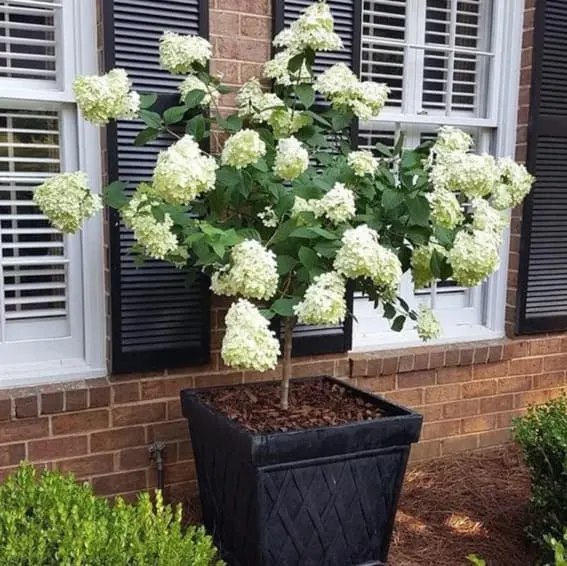
White Hydrangeas are beautiful plants recognized for their massive globe-shaped clusters, or globes, with white blooms that blossom in the summertime.
They are frequently employed in garden borders, landscapes, and floral arrangements because of their stunning blooms and the ability to change color depending on the soil’s pH. They are an excellent choice for well-drained, moist soils.
They require a little shade but prefer full sun. They are relatively easy to maintain and can make a striking design when planted in a garden.
Flower: The flowers of White Hydrangeas consist of a variety of tiny, star-shaped flowers that create large, round clusters. The flowers vary in dimensions; some can be at least twelve inches across. Depending on the type, the flowers may remain white or change to a greenish tint as they grow.
Foliage: White Hydrangeas’ foliage consists of large dark green leaves that form an abundant, full background to the stunning flowers. The leaves are attractive throughout the growing season and add to the overall beauty of the plant.
Toxicity: The cyanogenic glycosides in the flowers of Hydrangeas are harmful to humans and animals. Symptoms of ingestion could include vomiting, nausea, and diarrhea. These herbs must be kept out of the reach of pets and children to avoid accidental consumption.
8. White Carnation (Dianthus caryophyllus)
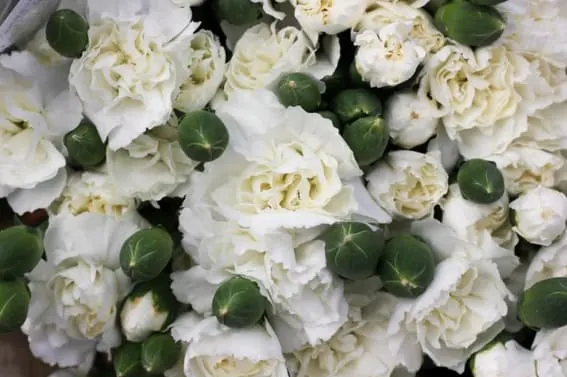
White Carnations are famous for their ruffled and fragrant petals and are frequently utilized for bouquets, corsages, and garden displays.
The flowers symbolize purity, luck, and respect. They bloom from late spring through early summer and can bring an elegant touch to any space.
White Carnations flourish in well-drained soil and receive plenty of sunshine, making them an excellent selection for different styles of gardens and containers.
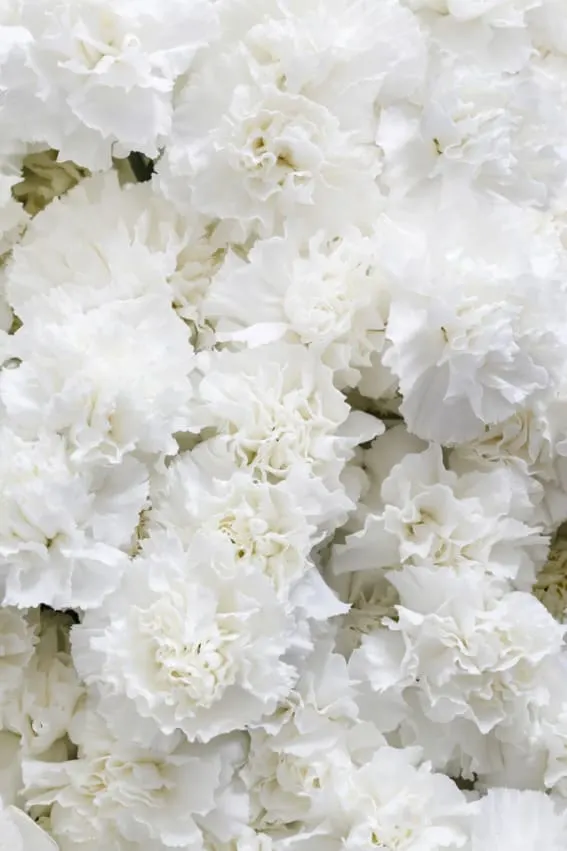
Flowers: The flowers of White Carnations feature densely packed and ruffled petals, which make the appearance of a lush, smooth bloom.
The average size of each flower is two to three inches across and has a pleasing clove-like scent. They come in double and single varieties.
Foliage: The foliage on White Carnations consists of slender gray-green leaves that grow around robust stems. The leaves create a delicate and attractive backdrop to the stunning flowers.
Toxicity: White carnations have minor toxic components that can cause stomach upsets if consumed by animals or humans.
Symptoms could include drooling, vomiting, and mild skin irritation. To prevent accidental consumption, keeping these plants out of the reach of children and pets is recommended.
A House Wrapped in White Roses
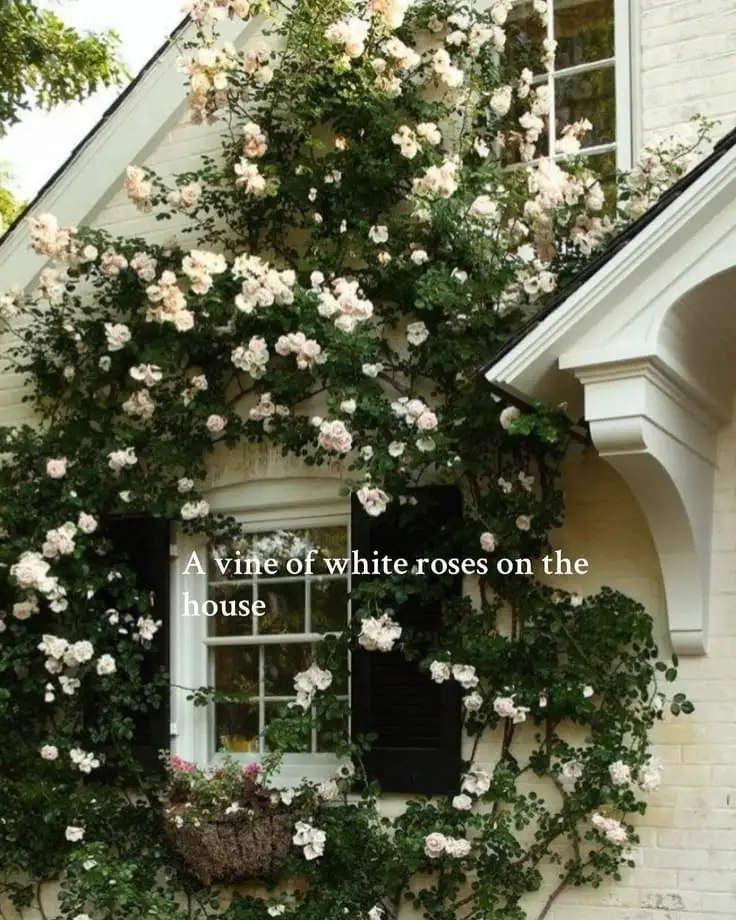
Image Source via @cain.rosenfeld on Instagram
This home is straight out of a fairy tale. White roses are growing up the walls and surrounding the windows, imbuing the exterior with as much romance and old-world charm as can be ogled.
The blooms pop against the dark shutters and light brick, while a flower box below the window adds a second layer of loveliness.
It’s the sort of home that feels welcoming, peaceful and forever in bloom.
Tips to Preventing and Managing Pests and Diseases
The maintenance of healthy white flowers requires active management of diseases and pests.
Check your plants regularly for signs of pests, such as spider mites, aphids, and caterpillars. Insecticidal soaps or oil can help control these insects.
You should also ensure enough air circulation within your plants to prevent fungal diseases such as black spots and powdery mildew, which could affect White Roses and Hydrangeas.
Correct watering methods like watering the plant’s roots and avoiding watering overhead to prevent fungal problems.
Mulching helps retain soil moisture and reduce weeds’ growth, reducing competition for nutrients.
Also, cleaning the garden by clearing fallen leaves and other debris will lower the risk of contracting disease.
When you select the best white flowers and give them adequate care, you can create a stunning, elegant garden that will add a perfect touch of class to your outdoor space.
UP NEXT: 21 Tasty Fruit-Bearing House Plants You Can Enjoy Indoors
Author: Everything Abode
Welcome to Everything Abode, your daily inspiration for every activity at home!
Our goal is to inspire you to live an elegant and chic lifestyle from the comfort of your home.
We’ll help you express yourself through authentic style, aesthetic beauty, and stylish home decor.
How to Care for the Mesmerizing Black Bat Flower
30+ Best Rock Garden Ideas You Should Try Today
Mediterranean Garden Ideas: Crafting Your Own Outdoor Sanctuary
15 Stunning Pink Houseplants You Need For Your Home ASAP
12 Outdoor Garden Shelves for Plants to Make Any Garden Look Gorgeous
6 Easy Vegetables That Grow on a Trellis
Subscribe to Get the Tools That Make My Blog Successful!

When you join my newsletter, I'm going to send you insider advice and tools that I use to grow my blog! I only save the BEST for my email list so don't wait!
